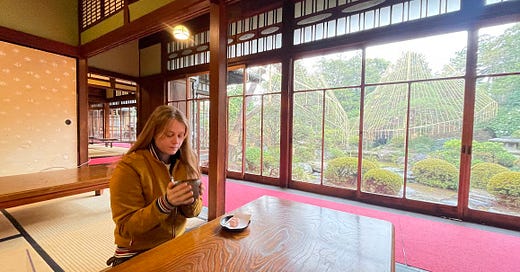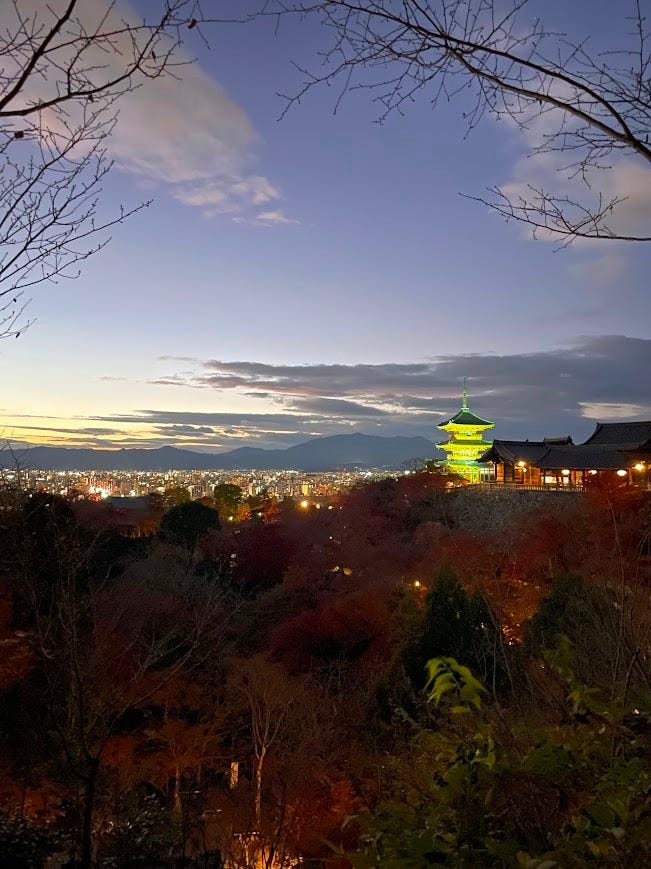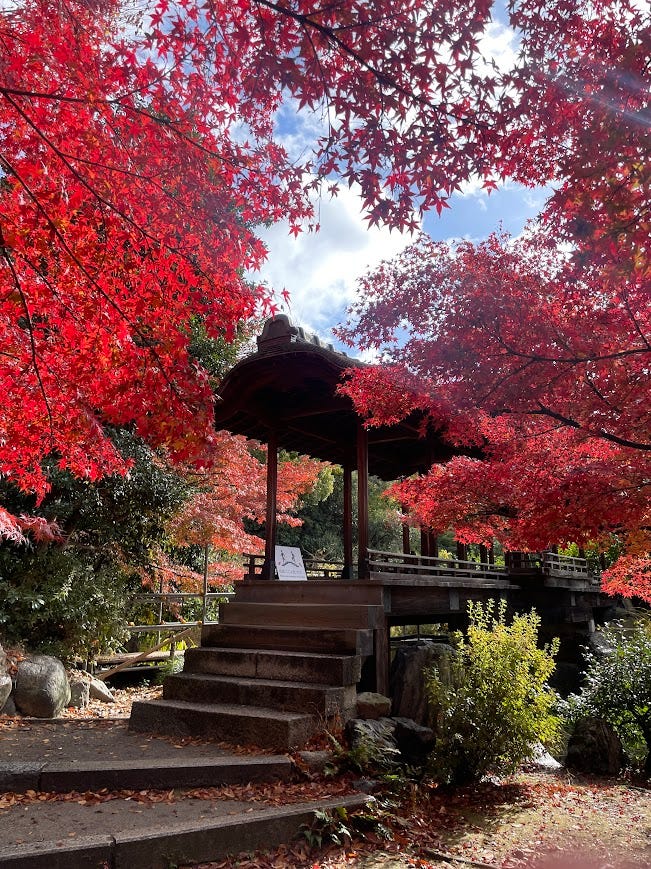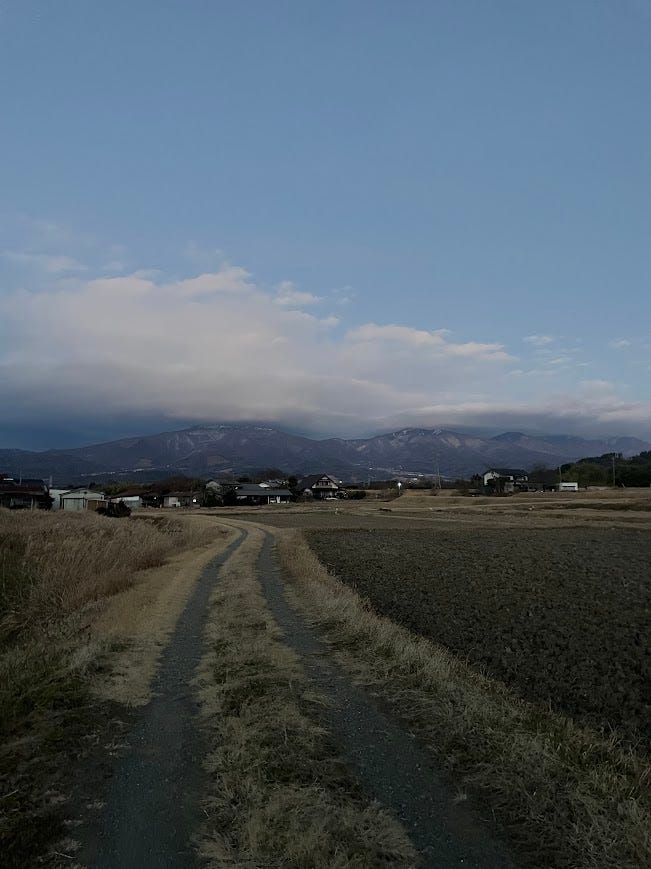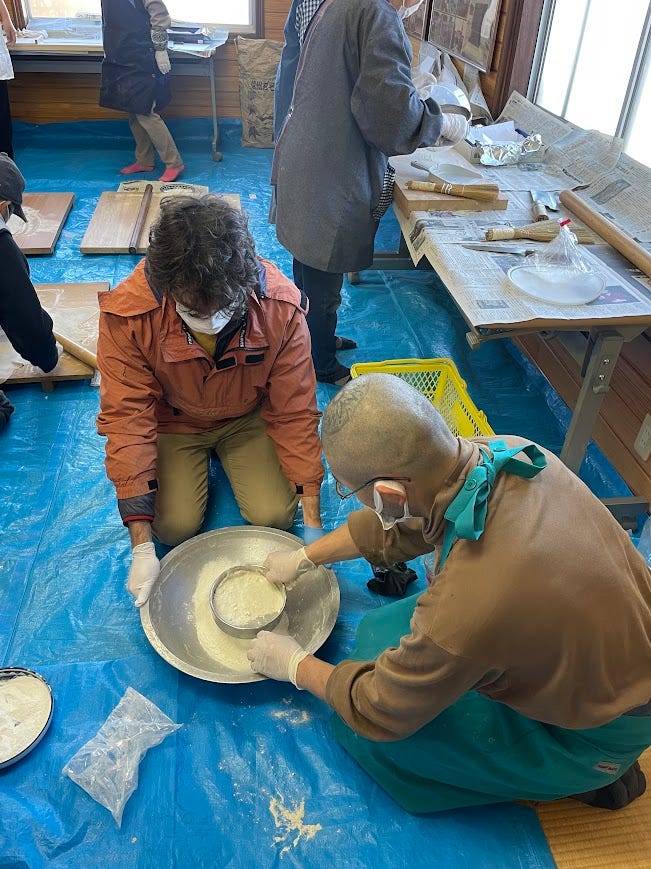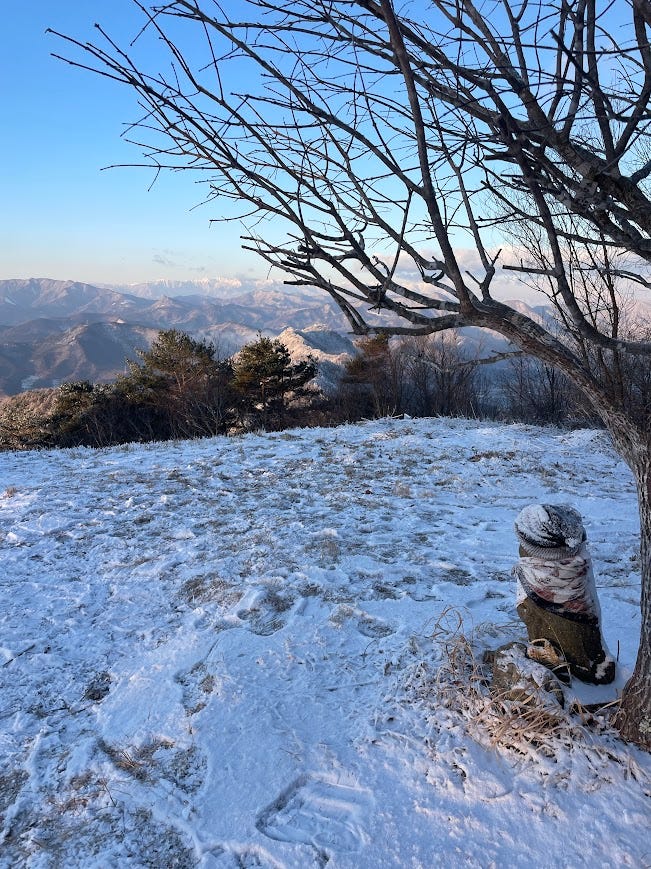Speeding Up, Slowing Down
Resisting the list-ification of travel. Plus, New Year’s festivities in rural Japan!
When I was 22, I took my first solo international trip. I hadn’t set out to travel alone – I had taken the dicey bargain of being bumped from a flight in exchange for two free round-trip tickets on Spirit Airlines. The agreement required me to book the tickets in short order. Ignoring the travel agent urging “wouldn’t you just like a long weekend in Atlanta?”, I scheduled a trip to Ecuador.
Despite my initial hesitance, solo travel suited me! I did lots of journaling, sketching, and wandering around food markets. However, I chased one too many waterfalls on a hike in Cuenca, and had to spend more time resting in my backpackers’ “pod hostel” in Quito than originally planned. Nursing bruises and gashes in my knee, I was surprised to observe just how many travelers were also lying around all day. Listening to their ambient conversations from behind my pod curtain, I learned many of them were traveling for several months to a year. I reflected on whether I felt a desire to be like them, and quickly decided not. Why travel for so long if so much of it was wasted on downtime? My approach was surely better – I had figured out how to do all the best things in a short period of time so that I didn’t need to stay longer.
I am now at the end of the exact type of year of travel that seven years ago I confidently concluded I wouldn’t crave. Sustaining a year of travel necessitates periods of downtime, and having “days off” in another country is an experience in itself! Maybe my attitude towards my pod-neighbors in 2018 was simply a way of coping with only having two weeks of time off a year. But I think the conviction also came from a deeper belief that permeates so much of the media we consume about travel. In doing research for a trip, there is a not-so-subtle encouragement to pack in as much as we can, or at least the very least the best things. Lists and blogs (that increasingly seem like slightly different versions of the same AI scripts or sponsored ads) tell us the “must-dos” in a given place, distilling entire regions and cultures down into their so-called greatest hits. I find myself reading articles like “how many days do you need in Kyoto?” that assume the goal is to consume everything the Internet has agreed is important, and then dash off as quickly as you can to the next destination. Sometimes, the phrasing almost seems designed to prematurely manufacture regret -- “you can’t go to x country and miss y!” They offer the elusive promise of both guiding you to experiences that are unique and “off the beaten path” (a phrase worth unpacking in itself), while also making sure you get the same Instagram shots as everyone else.
Of course, these resources can be incredibly useful! Chasing wanderlust without an agenda isn’t always safe, practical, or enjoyable. And while I’ve come to accept this year that I can’t do it all, lists can still help me to prioritize! I love a good dog-eared copy of Lonely Planet as much as the next traveler. These guides have led me to variety shows, a yard full of teapots, and other charming spots I probably wouldn’t have found on my own. But the dominant framing of travel media, and how it bleeds into conversations with others about travel, puts me into a consumeristic mindset that can drain the pleasure out of new places and experiences. It can turn travel into a to-do list, ironically the very thing I am often seeking a break from by going on vacation.
As I’ve written about in my posts on sabbaticals, the average amount of time off over the course of a career is too little for truly transformative experiences of exploration and rest. Short trips where you have to go home by the time you finally start to feel immersed or relaxed are all most people get. Based on my own description of the burnout that prompted this recess, it would be easy to think that I had spent the previous several years trapped in my office, that I was limited by too few opportunities to pursue these short, optimized trips. But in 2023, and I say this as a confession rather than a brag, I went on three separate international trips over the course of six months. I thought I was the queen of maximizing PTO, but my body had the final word, as I became ill during every trip with repercussions that lasted for weeks or months. The first trip, a vacation to Cuba with a friend, was mentally stimulating and restful in the ideal proportion. But the high didn’t last. So I planned more trips, during which I often battled a sense of dread that I had to enjoy every moment. In the narrow mindset of my unhappiness, I wondered if I didn’t make the most of this time away from my job and my life at home, then what did I have to keep me going? So I went to all the sites you just can’t miss and waited to feel like I was having fun.
Our arrival in Japan was nothing short of overwhelming. I had spent nearly a year learning the art of slower travel, and suddenly I was in one of the most sought-after, activity-dense regions in the world. At the same time, I was on short deadlines for job screening exams (two of which were due on Christmas Day and New Year’s Day, which I can’t help but note indignantly). I really loved Japanese cities, especially Kyoto. But I have to admit that at times I felt tasked by the work of tourism, of researching activities and having to complete them. While our year has included a lot of sightseeing, it’s our daily routines that have kept us going. My body hit a wall at the beginning of our eleven days in Tokyo, our longest stretch of “pure tourism” for the year. I had spent seven weeks studying for a serious exam. I was sleeping poorly with the ambient noise. We were at the end of a year of travel that, while restful in many ways, has been incredibly varied and full. I daydreamed about spending all day on the couch in Rhode Island, while knowing I would be nostalgic for my travels once I was there. We slowed down our days, but somehow I still needed to go even slower. Ultimately, my body set its own limits. I started sleeping in late nearly every day, a move I would have previously considered wasting precious time that I could be maximizing potential time for travel experiences. We enjoyed our afternoons, but tried not to pressure ourselves to stay out late or do any more than felt good. I did frivolous things with my evenings, like reading celebrity gossip. In letting myself rest and releasing myself from the pressure to do it all, I regained some of my energy and enjoyed the things we actually did a lot more.
Ultimately, I feel like we still had approximately the same experience in Tokyo than if we had tried to do the most. We ate incredible food, visited striking Shinto shrines, and wandered through loads of cool neighborhoods.
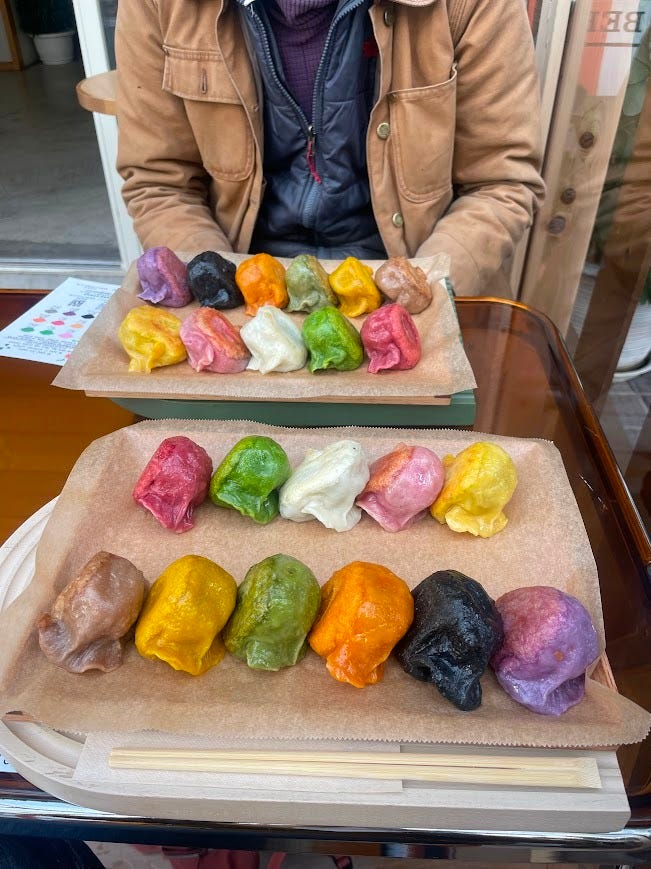
And yet, a small part of me still winces when I think about the recommendations from friends or lists that we skipped. I’m still learning how not to treat travel like a to-do list of which I am the Best Completer. I can’t optimize travel to be only fun and never tiring or stressful, as much as I might try. In trying to maximize, you risk checking off a list of activities without taking a moment to experience anything at all. Often the best travel experiences I’ve had are the ones I just allowed to happen by being present, not forcing it. When I think back on that trip to Ecuador, I would have to Google to remember the names of all the “must-see” places I know that I visited. What I remember is the walk to get ice cream I took with my BnB host and her grandchildren, a cafe I wandered into with rotating short theatre productions, and the three hours I spent yapping with chatty nail salon technicians to kill time before my flight home. I imagine Chris and I will cherish a similar, sometimes arbitrary, collection of things when the dust settles on our time in Japan, and all of the places we’ve been this year.

Our Last Workaway (for now!)
Spending a year traveling quickly reinforces the understanding that you can’t do it all. Once you are out of the section of the guide that shows you how to traverse an entire country from top to bottom in 10 days, you start to observe how there’s even more to do. Rather than produce a feeling of overwhelm, this has calmed me. Now that I’ve accepted I can’t do everything, that frees me to do the things I actually want to do (a key thesis of a recent read, 4000 Weeks). This year, one of those big things has been volunteering! As I’ve written about time and time again, something about WWOOFing/Workaway just works for me. It gives me the structure I need to not feel like I need to evaluate how I’m spending every hour of my time. In making meaningful commitments (limitations!) on my time rather than being in a state of completely open travel, I more deeply enjoyed our experiences, including our free time.
Our last Workaway of the year was no exception to this grounded form of travel. We stayed with a couple in rural Japan, a few kilometers outside of a small city in the Nagano prefecture. They have a rice and vegetable farm, which is just for sustaining their own needs and that of a few neighbors. Almost every meal had Japanese sweet potato, pumpkin, daikon, taro, or rice grown just outside our window! Eating their home-grown food really drove home a message our Buddhist Templestay host in Korea had offered in order to encourage us to clean our plates: every grain of rice is someone’s labor. Part-time, they also work for an organization that offers programming for people struggling with depression. While we’ve loved staying with so many retired hosts this year, it was a fun switch to stay with a couple closer to our age. Before becoming a farmer, our host had also done similar years of travel, including Workaway and a working holiday in New Zealand!
We also really enjoyed getting to experience life in rural Japan. We explored historic onsen towns, and went to the bathhouses at least twice a week. We checked out old castle ruins and even managed to go skiing.
We ate Japanese comfort foods, like homemade mochi and okonomiyaki. Given the winter temperatures, we spent most of our working time chopping firewood. Since our stay spanned the holiday season, we also helped with holiday activities! We cooked a classic American-style Christmas dinner for our hosts and a couple of their friends. Most people do a big ritual cleaning (ōsōji) at the end of the year, so we helped tend to the house and a family shrine. We provided extra hands for a big family New Year’s bento box lunch (osechi ryori) and made new scarecrows (kakashi) to protect next season’s crops.
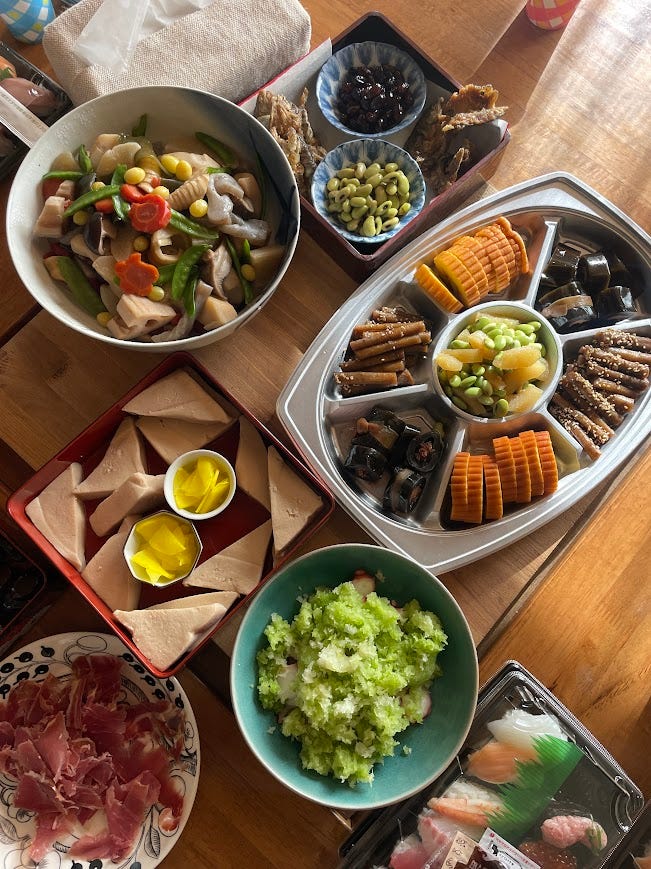
We hadn’t realized that New Year’s is Japan’s most important holiday, and we were lucky to participate in so many traditions. At a local community center, we braided rice straw to hang over doorways as a marker of the New Year. Soba noodles are especially popular around New Year’s, and we got to watch them be made from scratch!
We went to the local shrine at midnight for sake and snacks. We woke up at 4am for hatsuinode, the tradition of hiking a mountain to see the first sunrise of the New Year. It was freezing and exhausting, but definitely one of the more meaningful ways I’ve marked the passage of time. On our last night, we had a big bonfire to burn the old scarecrow along with some personal effects for good tidings in the New Year.
If given a month to travel in Japan, most people would probably not decide to spend half of it in the rural outskirts of Ueda City. While it boasts castle ruins and serves as a halfway point to ski slopes, it’s not a major destination. But we really like how volunteering encourages us to experience parts of the country we might not have otherwise. Chris and I have even discussed whether we would consider WWOOFing/Workaway on shorter trips in the future. On one hand, it might feel difficult to go on a weeklong vacation and forego doing allthethings. On the other hand, our volunteering and exchange experiences provide much of what we are actually seeking from travel. I can’t recommend it enough!
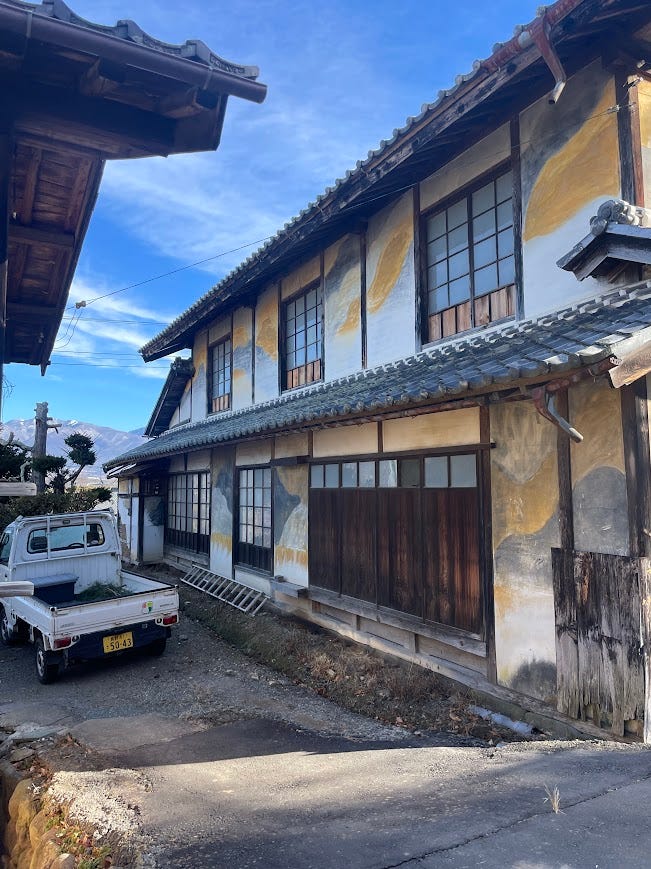
What’s Next?
We had a one-night layover in Houston, which felt symbolic given that my recess year officially started with “h-town slowdown.” I’m looking forward to sitting by the fire and relaxing as we adjust back to life in Rhode Island. Then I’m hoping to spend some time visiting family and friends, which also feels like a beautiful bookend given how the year started! It seems like a paradox that during a year abroad I’ve ended up seeing friends and family perhaps more extensively than I normally do. I spent almost three months visiting friends and family in the U.S. before leaving for New Zealand. We came back in August for two weddings, during which we spent extended time with friends and both of our families. And now, we are both excited to spend some time nurturing our relationships back home as we figure out our next steps.
In deciding to end our travels, Chris and I talked a lot about how we are eager to build community that is rooted in the next place that we live. While we’ve been lucky to find community on our travels, we are craving some consistency. But right now, we are in a limbo period as I wait to hear back from jobs. And I miss everyone! I feel like the best way I can prioritize community right now is use my abundance of time to visit people more slowly, instead of crammed over a few days or a weekend.
The current plan is that Chris will stay in Rhode Island and start substitute teaching. He already has a D&D campaign planned with back-home friends and is eager to start baking up a storm. I’m looking into a train trip! Just a few months ago, Amtrak officially launched the Floridian line, which has daily service between Chicago and Miami. While I don’t plan to venture into the Midwest, the line picks up on the East Coast, making for convenient connections with the Northeast Regional. I have many stops I’m excited to make on the way on my own version of “Ticket to Ride.” I’ll write more about the transition back and this domestic chapter of Recess once I’ve pieced it together! Can’t wait to see everyone over the next few months <3

